Analysis of Development Trends for Rotating Detonation Engines Based on Experimental Studies
Abstract
:1. Introduction
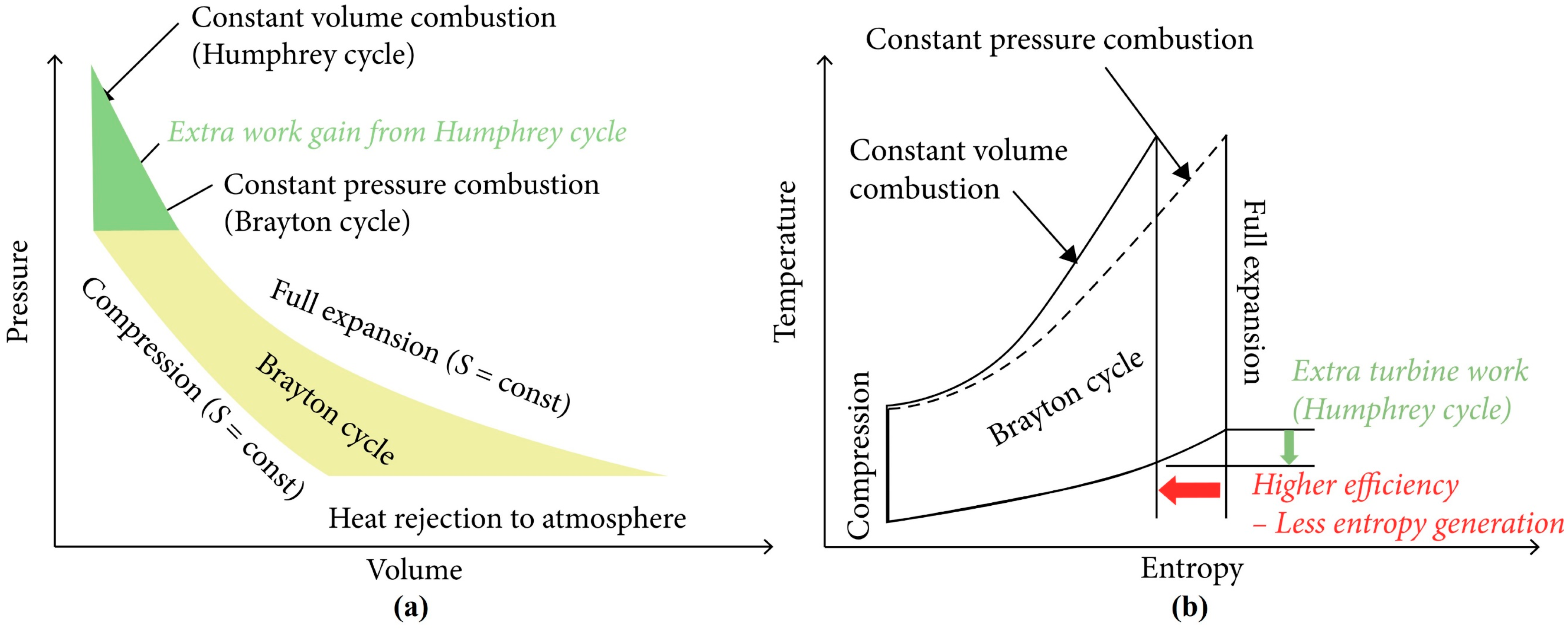
2. RDE Research and Development by Country
2.1. United States
2.2. Russia
2.3. France
2.4. Germany
2.5. Poland
2.6. Japan
2.7. China
3. Research Trend Analysis
3.1. Summary of Research and Development
3.2. RDE Performance
3.3. Research and Development Issues
4. Conclusions
Author Contributions
Funding
Data Availability Statement
Conflicts of Interest
References
- Wintenberger, E.; Sepherd, J.E. Thermodynamic cycle analysis for propagating detonations. J. Propuls. Power 2006, 22, 694–698. [Google Scholar] [CrossRef]
- Viktorovich, B.P. About the detonation engine. Am. J. Appl. Sci. 2014, 11, 1357. [Google Scholar] [CrossRef]
- Lisanti, J.C.; Zhu, X.; Roberts, W.L. Improving the Performance of an Active Valve Resonant Pulse Combustor. In Proceedings of the AIAA Propulsion and Energy 2019 Forum, Indianapolis, IN, USA, 19–22 August 2019; p. 3871. [Google Scholar]
- Akbari, P.; Nalim, M.R. Review of recent developments in wave rotor combustion technology. J. Propuls. Power 2009, 25, 833–844. [Google Scholar] [CrossRef]
- Nayana, K.; Veerbhadrappa, S.; Akshay, N. Wave Rotor. Int. J. Adv. Res. Sci. Eng. 2018, 7, 53–62. [Google Scholar]
- Wolański, P. Detonation engines. J. KONES 2011, 18, 515–521. [Google Scholar]
- Zhou, R.; Wu, D.; Wang, J. Progress of continuously rotating detonation engines. Chin. J. Aeronaut. 2016, 29, 15–29. [Google Scholar] [CrossRef]
- Voitsekhovskii, B.V.; Mitrofanov, V.V.; Topchiyan, M.E. Structure of the detonation front in gases (survey). Combust. Explos. Shock. Waves 1969, 5, 267–273. [Google Scholar] [CrossRef]
- Li, J.; Zhang, K.; Li, W.; Yuan, L. Investigation of Pressure Rise and Flame Acceleration Characteristics in a Single Channel of Wave Rotor Combustor with Spoilers. Int. J. Aerosp. Eng. 2019, 2019, 6259204. [Google Scholar] [CrossRef]
- Nlcholls, J.A.; Cullen, R.E.; Ragland, K.W. Feasibility studies of a rotating detonation wave rocket motor. J. Spacecr. Rocket. 1966, 3, 893–898. [Google Scholar] [CrossRef]
- Braun, E.; Dunn, N.; Lu, F. Testing of a Continuous Detonation Wave Engine with Swirled Injection. In Proceedings of the 48th AIAA Aerospace Sciences Meeting Including the New Horizons Forum and Aerospace Exposition, Orlando, FL, USA, 1–7 January 2010; p. 146. [Google Scholar]
- Russo, R.M. Operational Characteristics of a Rotating Detonation Engine Using Hydrogen and Air. Master’s Dissertation, Air Force Institute of Technology, Dayton, OH, USA, 2011. [Google Scholar]
- Russo, R.; King, P.; Schauer, F.; Thomas, L. Characterization of Pressure rise across a Continuous Detonation Engine. In Proceedings of the 47th AIAA/ASME/SAE/ASEE Joint Propulsion Conference & Exhibit, San Diego, CA, USA, 31 July–3 August 2011; p. 6046. [Google Scholar]
- Shank, J.; King, P.; Karnesky, J.; Schauer, F.; Hoke, J. Development and Testing of a Modular Rotating Detonation Engine. In Proceedings of the 50th AIAA Aerospace Sciences Meeting including the New Horizons Forum and Aerospace Exposition, Nashville, TN, USA, 9–12 January 2012; p. 0120. [Google Scholar]
- Shank, J.C. Development and Testing of a Rotating Detonation Engine Run on Hydrogen and Air. Master’s Dissertation, Air Force Institute of Technology, Dayton, OH, USA, 2012. [Google Scholar]
- Tellefsen, J.; King, P.; Schauer, F.; Hoke, J. Analysis of an RDE with Convergent Nozzle in Preparation for Turbine Integration. In Proceedings of the 50th AIAA Aerospace Sciences Meeting including the New Horizons Forum and Aerospace Exposition, Nashville, TN, USA, 9–12 January 2012; p. 0773. [Google Scholar]
- Keller, P.K.; Polanka, M.D.; Schauer, F.R.; Wyatt, J.J.; Sell, B.C. Low mass-flow operation of small-scale rotating detonation engine. Appl. Therm. Eng. 2024, 241, 122352. [Google Scholar] [CrossRef]
- St. George, A.C.; Driscoll, R.B.; Munday, D.E.; Gutmark, E.J. Development of a Rotating Detonation Engine Facility at the University of Cincinnati. In Proceedings of the 53rd AIAA Aerospace Sciences Meeting, Kissimmee, FL, USA, 5–9 January 2015; p. 0635. [Google Scholar]
- Walters, I.V.; Journell, C.; Lemcherfi, A.; Gejji, R.; Heister, S.D.; Slabaugh, C.D. Experimental Investigation of a Piloted, Natural Gas-Air Rotating Detonation Wave Combustor. In Proceedings of the 2018 Joint Propulsion Conference, Cincinnati, OH, USA, 9–11 July 2018; p. 4782. [Google Scholar]
- Kubicki, S.W.; Anderson, W.; Heister, S.D. Further Experimental Study of a Hypergolically-Ignited Liquid-Liquid Rotating Detonation Rocket Engine. In Proceedings of the AIAA Scitech 2020 Forum, Orlando, FL, USA, 6–10 January 2020; p. 0196. [Google Scholar]
- Sosa, J.; Burke, R.; Ahmed, K.A.; Micka, D.J.; Bennewitz, J.W.; Danczyk, S.A.; Paulson, E.J.; Hargus, W.A., Jr. Experimental Evidence of H2/O2 Propellants powered Rotating Detonation Waves. Combust. Flame 2020, 214, 136–138. [Google Scholar] [CrossRef]
- Chacon, F.; Gamba, M. Development of an optically accessible continuous wave Rotating Detonation Engine. In Proceedings of the 2018 Joint Propulsion Conference, AIAA 2018-4876, Cincinnati, OH, USA, 9–11 July 2018. [Google Scholar]
- Chacon, F.; Gamba, M. OH PLIF Visualization of an Optically Accessible Rotating Detonation Combustor. In Proceedings of the AIAA Propulsion and Energy Forum, Indianapolis, IN, USA, 19–22 August 2019. [Google Scholar]
- Unruh, E.C.; Spaulding, M.; Lineberry, D.M.; Xu, K.G.; Frederick, R.A. Development of an Optically Accessible Racetrack-Type Rotating Detonation Rocket Engine. In Proceedings of the AIAA Propulsion and Energy 2020 Forum, Virtual, 24–28 August 2020; p. 3868. [Google Scholar]
- Unruh, E.; Venters, J.; Hemming, M.; Lineberry, D.; Xu, K.G.; Frederick, R. Experimental Study of a Racetrack-Type Rotating Detonation Rocket Engine with Liquid-Fuel Shear-Coaxial Injectors. In Proceedings of the 68th JANNAF Propulsion Meeting-12th Liquid Propulsion Subcommittee-Rotating Detonation Engine Session, Virtual, 7–17 June 2021. [Google Scholar]
- Stout, J.; Lynch, E.D.; Claflin, S.; Darby, A. Rotating Detonation Combustion for Gas Turbines–Modeling and System Synthesis to Exceed 65% Efficiency Goal (Phase II); Aerojet Rocketdyne DOE-AR-23983; Aerojet Rocketdyne, Inc.: Canoga Park, CA, USA, 2019. [Google Scholar]
- Sprouse, K.; Lynch, E.; Stout, J.; Claflin, S.; Darby, A. An Overview of Rotating Detonation Engine Development at Aerojet Rocketdyne. In Proceedings of the ASEM Turbo Expo, Oslo, Norway, 14 June 2018. [Google Scholar]
- Thomas, L.M.; Schauer, F.R.; Hoke, J.L.; Naples, A. Buildup and Operation of a Rotating Detonation Engine. In Proceedings of the 49th AIAA, Orlando, FL, USA, 4–7 January 2011. [Google Scholar]
- Rankin, B.A.; Richardson, D.R.; Caswell, A.W.; Naples, A.; Hoke, J.; Schauer, F. Imaging of OH* Chemiluminescence in an Optically Accessible Nonpremixed Rotating Detonation Engine. In Proceedings of the 53rd AIAA Aerospace Sciences Meeting, Kissimmee, FL, USA, 5–9 January 2015. [Google Scholar]
- Rankin, B.A.; Richardson, D.R.; Caswell, A.W.; Naples, A.G.; Hoke, J.L.; Schauer, F.R. Chemiluminescence imaging of an optically accessible non-premixed rotating detonation engine. Combust. Flame 2017, 176, 12–22. [Google Scholar] [CrossRef]
- Fotia, M.L.; Schauer, F.; Kaemming, T.; Hoke, J. Experimental Study of the Performance of a Rotating Detonation Engine with Nozzle. J. Propuls. Power 2016, 32, 674–681. [Google Scholar] [CrossRef]
- Fotia, M.L.; Hoke, J.; Schauer, F. Experimental Performance Scaling of Rotating Detonation Engines Operated on Gaseous Fuels. J. Propuls. Power 2017, 33, 1187–1196. [Google Scholar] [CrossRef]
- Hargus, W.A., Jr.; Schumaker, S.A.; Paulson, E.J. Air Force Research Laboratory Rotating Detonation Rocket Engine Development. In Proceedings of the 2018 Joint Propulsion Conference, AIAA 2018-4876, Cincinnati, OH, USA, 9–11 July 2018. [Google Scholar]
- Bennewitz, J.W.; Bigler, B.R.; Ross, M.C.; Danczyk, S.A.; Hargus, W.A., Jr.; Smith, R.D. Performance of a Rotating Detonation Rocket Engine with Various Convergent Nozzles and Chamber Lengths. Energies 2021, 14, 2037. [Google Scholar] [CrossRef]
- Ferguson, D. Pressure Gain Combustion Technology Development for Gas Turbine Engines. In Proceedings of the National Energy Technology Laboratory (NETL), 2021 UTSR Virtual Review Mtg., Virtual, 8–10 November 2021. [Google Scholar]
- NASA Validates Revolutionary Propulsion Design for Deep Space Missions. Available online: https://www.nasa.gov/centers-and-facilities/marshall/nasa-validates-revolutionary-propulsion-design-for-deep-space-missions/ (accessed on 27 September 2023).
- Frolov, S.M.; Zvegintsev, V.I.; Ivanov, V.S.; Aksenov, V.S.; Shamshin, I.O.; Vnuchkov, D.A.; Nalivaichenko, D.G.; Berlin, A.A.; Fomin, V.M. Wind Tunnel Tests of a Hydrogen-Fueled Detonation Ramjet Model at Approach Air Stream Mach Numbers from 4 to 8. Int. J. Hydrogen Energy 2017, 42, 25401–25413. [Google Scholar] [CrossRef]
- Frolov, S.M.; Zvegintsev, V.I.; Ivanov, V.S.; Aksenov, V.S.; Shamshin, I.O.; Vnuchkov, D.A.; Nalivaichenko, D.G.; Berlin, A.A.; Fomin, V.M.; Shiplyuk, A.N.; et al. Hydrogen-Fueled Detonation Ramjet Model: Wind Tunnel Tests at Approach Air Stream Mach Number 5.7 and Stagnation Temperature 1500 K. Int. J. Hydrogen Energy 2018, 43, 7515–7524. [Google Scholar] [CrossRef]
- Frolov, S.M.; Aksenov, V.S.; Ivanov, V.S.; Shamshin, I.O. Continuous Detonation Combustion of Ternary ‘Hydrogen–Liquid Propane–Air’ Mixture in Annular Combustor. Int. J. Hydrogen Energy 2017, 42, 16808–16820. [Google Scholar] [CrossRef]
- Ivanov, V.S.; Frolov, S.M.; Zangiev, A.E.; Zvegintsev, V.I.; Shamshin, I.O. Hydrogen fueled detonation ramjet: Conceptual design and test fires at Mach 1.5 and 2.0. Aerosp. Sci. Technol. 2021, 109, 106459. [Google Scholar] [CrossRef]
- Frolov, S.M.; Ivanov, V.S.; Shamshin, I.O.; Aksenov, V.S.; Vovk, M.Y.; Mokrynskij, I.V.; Bruskov, V.A.; Igonkin, D.V.; Moskvitin, S.N.; Illarionov, A.A.; et al. A Detonation Afterburner. Dokl. Phys. 2020, 65, 36–39. [Google Scholar] [CrossRef]
- Vasiliv, S.; Pryadko, N.; Strelnikov, H.; Dzuba, S. Application of detonation in impulse systems of energy engineering and mining industry. IOP Conf. Ser. Earth Environ. Sci. 2023, 1156, 012004. [Google Scholar] [CrossRef]
- Le Naour, B.; Falempin, F.; Miquel, F. Recent experimental results obtained on Continuous Detonation Wave Engine. In Proceedings of the 17th AIAA International Space Planes and Hypersonic Systems and Technologies Conference, San Francisco, CA, USA, 11–14 April 2011. [Google Scholar]
- Le Naour, B.; Falempin, F.H.; Coulon, K. MBDA R&T Effort Regarding Continuous Detonation Wave Engine for Propulsion—Status in 2016. In Proceedings of the 21st AIAA International Space Planes and Hypersonics Technologies Conference, Xiamen, China, 6–9 March 2017. [Google Scholar]
- Bach, E.; Bohon, M.; Paschereit, C.O.; Stathopoulos, P. Influence of nozzle guide vane orientation relative to RDC wave direction. In Proceedings of the AIAA Propulsion and Energy Forum, Indianapolis, IN, USA, 19–22 August 2019. [Google Scholar]
- Bach, E.; Paschereit, C.O.; Stathopoulos, P.; Bohon, M.D. An empirical model for stagnation pressure gain in rotating detonation combustors. Proc. Combust. Inst. 2021, 38, 3807–3814. [Google Scholar] [CrossRef]
- Bluemner, R.; Paschereit, C.O.; Gutmark, E.J.; Bohon, M. Investigation of longitudinal operating modes in rotating detonation combustors. In Proceedings of the AIAA SciTech Forum, Orlando, FL, USA, 6–10 January 2020. [Google Scholar]
- Kindracki, J. Experimental research on rotating detonation in liquid fuel–gaseous air mixtures. Aerosp. Sci. Technol. 2015, 43, 445–453. [Google Scholar] [CrossRef]
- Wolański, P.; Kalina, P.; Balicki, W.; Rowiński, A.; Perkowski, W.; Kawalec, M.; Łukasik, B. Development of Gasturbine with Detonation Chamber. In Detonation Control for Propulsion: Pulse Detonation and Rotating Detonation Engines; Springer: Berlin/Heidelberg, Germany, 2018; pp. 23–37. [Google Scholar]
- Wolański, P.; Balicki, W.; Perkowski, W.; Bilar, A. Experimental research of liquid-fueled continuously rotating detonation chamber. Shock. Waves 2021, 31, 807–812. [Google Scholar] [CrossRef]
- Wolański, P.; Kawalec, M. Experimental Research of Performance of Combined Cycle Rotating Detonation Rocket-Ramjet Engine. In Proceedings of the 27th International Colloquium on the Dynamics of Explosions and Reactive Systems, Beijing, China, 28 July–2 August 2019. [Google Scholar]
- Kawalec, M.; Perkowski, W.; Łukasik, B.; Bilar, A.; Wolański, P. Applications of the continuously rotating detonation to combustion engines at the Łukasiewicz-Institute of Aviation. Combust. Engines 2022, 191, 51–57. [Google Scholar] [CrossRef]
- Kawalec, M.; Wolański, P. Development of Rocket Engine with Continuously Rotating Detonation supplied by Liquid Propellants. In Proceedings of the 9th European Conference for Aeronautics and Space Sciences, Lille, France, 27 June 2022. [Google Scholar]
- Wolanski, P.; Kindracki, J.; Fujiwara, T.; Oka, Y.; Shima-uchi, K. An experimental study of rotating detonation engine. In Proceedings of the 20th International Colloquium on the Dynamics of Explosions and Reactive Systems, Montreal, QC, Canada, 31–35 July 2005. [Google Scholar]
- Kawasaki, A.; Inakawa, T.; Kasahara, J.; Goto, K.; Matsuoka, K.; Matsuo, A.; Funaki, I. Critical condition of inner cylinder radius for sustaining rotating detonation waves in rotating detonation engine thruster. Proc. Combust. Inst. 2019, 37, 3461–3469. [Google Scholar] [CrossRef]
- Goto, K.; Nishimura, J.; Higashi, J.; Taki, H.; Ukai, T.; Hayamizu, Y.; Kikuchi, K.; Yamada, T.; Watanabe, S.; Hotta, K.; et al. Preliminary Experiments on Rotating Detonation Rocket Engine for Flight Demonstration using Sounding Rocket. In Proceedings of the 2018 AIAA Aerospace Sciences Meeting, Kissimmee, FL, USA, 8–12 January 2018. [Google Scholar]
- Goto, K.; Yokoo, R.; Kawasaki, A.; Matsuoka, K.; Kasahara, J.; Matsuo, A.; Funaki, I.; Kawashima, H. Investigation into the effective injector area of a rotating detonation engine with impact of backflow. Shock. Waves 2021, 31, 753–762. [Google Scholar] [CrossRef]
- Goto, K.; Kato, Y.; Ishihara, K.; Matsuoka, K.; Kasahara, J.; Matsuo, A.; Funaki, I.; Nakata, D.; Higashino, K.; Tanatsugu, N. Thrust validation of rotating detonation engine system by moving rocket sled test. J. Propuls. Power 2021, 37, 419–425. [Google Scholar] [CrossRef]
- Goto, K.; Matsuoka, K.; Matsuyama, K.; Kawasaki, A.; Watanabe, H.; Itouyama, N.; Ishihara, K.; Buyakofu, V.; Noda, T.; Kasahara, J.; et al. Flight Demonstration of Detonation Engine System using Sounding Rocket S-520-31: Performance of Rotating Detonation Engine. In Proceedings of the AIAA SCITECH 2022 Forum, San Diego, CA, USA, 3–7 January 2022. [Google Scholar]
- The World’s First Space Flight for The Rotating Detonation Engine, and a Glimpse at a New Sample Return Capsule. Available online: https://cosmos.isas.jaxa.jp/the-worlds-first-space-flight-for-the-rotating-detonation-engine-and-a-glimpse-at-a-new-sample-return-capsule/ (accessed on 14 October 2023).
- Yokoo, R.; Goto, K.; Kim, J.; Kawasaki, A.; Matsuoka, K.; Kasahara, J.; Matsuo, A.; Funaki, I. Propulsion Performance of Cylindrical Rotating Detonation Engine. AIAA J. 2020, 58, 5107–5116. [Google Scholar] [CrossRef]
- Ishihara, K.; Yoneyama, K.; Sato, T.; Watanabe, H.; Itouyama, N.; Kawasaki, A.; Matsuoka, K.; Kasahara, J.; Matsuo, A.; Funaki, I. Visualization and Performance Evaluation of a Liquid-Ethanol Cylindrical Rotating Detonation Combustor. Trans. Jpn. Soc. Aero. Space Sci. 2023, 66, 46–58. [Google Scholar] [CrossRef]
- Ishihara, K.; Yoneyama, K.; Watanabe, H.; Itouyama, N.; Kawasaki, A.; Matsuoka, K.; Kasahara, J.; Matsuo, A.; Funaki, I.; Higashino, K. Thrust Performance of Converging Rotating Detonation Engine Compared with Steady Rocket Engine. J. Propuls. Power 2023, 39, 297–307. [Google Scholar] [CrossRef]
- Nakata, K.; Ishihara, K.; Goto, K.; Itouyama, N.; Watanabe, H.; Kawasaki, A.; Matsuoka, K.; Kasahara, J.; Matsuo, A.; Funaki, I.; et al. Experimental investigation of inner flow of a throatless diverging rotating detonation engine. Proc. Combust. Inst. 2023, 39, 3073–3082. [Google Scholar] [CrossRef]
- Goto, K.; Ota, K.; Kawasaki, A.; Itouyama, N.; Watanabe, H.; Matsuoka, K.; Kasahara, J.; Matsuo, A.; Funaki, I.; Kawashima, H. Cylindrical rotating detonation engine with propellant injection cooling. J. Propuls. Power 2022, 38, 410–420. [Google Scholar] [CrossRef]
- Sato, T.; Nakata, K.; Ishihara, K.; Itouyama, N.; Matsuoka, K.; Kasahara, J.; Kawasaki, A.; Nakata, D.; Eguchi, H.; Uchiumi, M.; et al. Combustion Structure of a Cylindrical Rotating Detonation Engine with Liquid Ethanol and Nitrous Oxide. Combust. Flame 2024, 264, 113443. [Google Scholar] [CrossRef]
- Nakagami, S.; Matsuoka, K.; Kasahara, J. Experimental Visualization of the Structure of Rotating Detonation Waves in a Disk-Shaped Combustor. J. Propuls. Power 2016, 33, 80–88. [Google Scholar] [CrossRef]
- Ishii, K.; Ohno, K.; Kawana, H.; Kawasaki, K.; Hayashi, A.K.; Tsuboi, N. Operation characteristics of a disk-type rotating detonation engine. Shock. Waves 2023, 33, 267–274. [Google Scholar] [CrossRef]
- Liu, S.J.; Lin, Z.Y.; Liu, W.D.; Lin, W.; Zhuang, F.C. Experimental Realization of H2/air Continuous Rotating Detonation in a Cylindrical Combustor. Combust. Sci. Technol. 2016, 184, 1302–1317. [Google Scholar] [CrossRef]
- Liu, S.J.; Lin, Z.Y.; Liu, W.D.; Lin, W.; Sun, M.B. Experimental and three-dimensional numerical investigations on H2/air continuous rotating detonation wave. Proc. IMechE Part G J. Aerosp. Eng. 2012, 227, 326–341. [Google Scholar] [CrossRef]
- Wei, L.; Jin, Z.; Shijie, L.; Zhiyong, L. An experimental study on CH4/O2 continuously rotating detonation wave in a hollow combustion chamber. Exp. Therm. Fluid Sci. 2015, 62, 122–130. [Google Scholar]
- Peng, H.Y.; Liu, W.D.; Liu, S.J.; Zhang, H.L. Realization of methane-air continuous rotating detonation wave. Acta Astronaut. 2019, 164, 1–8. [Google Scholar] [CrossRef]
- Fan, W.J.; Peng, H.Y.; Liu, S.J.; Sun, M.B.; Yuan, X.Q.; Zhang, H.L. Initiation process of non-premixed continuous rotating detonation wave through Schlieren visualization. Combust. Flame 2024, 265, 113437. [Google Scholar] [CrossRef]
- Liu, S.J.; Liu, W.D.; Wang, Y.; Lin, Z.Y. Free jet test of continuous rotating detonation ramjet engine. In Proceedings of the 21st AIAA International Space Planes and Hypersonics Technologies Conference, Xiamen, China, 6–9 March 2017. [Google Scholar]
- Peng, H.Y.; Liu, W.D.; Liu, S.J.; Zhang, H.L. The effect of cavity on ethylene-air Continuous Rotating Detonation in the annular combustor. Int. J. Hydrogen Energy 2019, 44, 14032–14043. [Google Scholar] [CrossRef]
- Peng, H.Y.; Liu, S.J.; Liu, W.D.; Yuan, W.Q.; Cai, X.D. Enhancement of ethylene-air continuous rotating detonation in the cavity-based annular combustor. Aerosp. Sci. Technol. 2021, 115, 106842. [Google Scholar] [CrossRef]
- Wang, Y.; Wang, J.; Li, Y.; Li, Y. Induction for multiple rotating detonation waves in the hydrogen–oxygen mixture with tangential flow. Int. J. Hydrogen Energy 2014, 39, 11792–11797. [Google Scholar] [CrossRef]
- Ma, J.Z.; Bao, W.; Wang, J.P. Experimental Research of the Performance and Pressure Gain in Continuous Detonation Engines with Aerospike Nozzles. Aerosp. Sci. Technol. 2023, 140, 108464. [Google Scholar] [CrossRef]
- Zhang, Y.; Sheng, Z.; Rong, G.; Shen, D.; Wu, K.; Wang, J. Experimental research on the performance of hollow and annular rotating detonation engines with nozzles. Appl. Therm. Eng. 2023, 218, 119339. [Google Scholar] [CrossRef]
- Wu, W.; Wang, Y.; Han, W.; Wang, G.; Zhang, M.; Wang, J. Experimental research on solid fuel pre-combustion rotating detonation engine. Acta Astronaut. 2023, 205, 258–266. [Google Scholar] [CrossRef]
- Peng, L.; Wang, D.; Wu, X.; Ma, H.; Yang, C. Ignition experiment with automotive spark on rotating detonation engine. Int. J. Hydrogen Energy 2015, 40, 8465–8474. [Google Scholar] [CrossRef]
- Zhou, S.; Ma, H.; Liu, D.; Yan, Y.; Li, S.; Zhou, C. Experimental study of a hydrogen-air rotating detonation combustor. Int. J. Hydrogen Energy 2017, 42, 14741–14749. [Google Scholar] [CrossRef]
- Wu, Y.; Weng, C.; Zheng, Q.; Wei, W.; Bai, Q. Experimental research on the performance of a rotating detonation combustor with a turbine guide vane. Energy 2021, 218, 119580. [Google Scholar] [CrossRef]
- Meng, H.; Xiao, Q.; Feng, W.; Wu, M.; Han, X.; Wang, F.; Weng, C.; Zheng, Q. Air-breathing rotating detonation fueled by liquid kerosene in cavity-based annular combustor. Aerosp. Sci. Technol. 2022, 122, 107407. [Google Scholar] [CrossRef]
- Li, X.F.; Li, J.Z.; Qin, Q.Y.; Jin, W.; Yuan, L. Experimental study on detonation characteristics of liquid kerosene/air rotating detonation engine. Acta Astronaut. 2024, 215, 124–134. [Google Scholar] [CrossRef]
- Zhou, S.; Ma, Y.; Liu, F.; Hu, N. Effects of a straight guide vane on the operating characteristics of rotating detonation combustor. Acta Astronaut. 2023, 203, 135–145. [Google Scholar] [CrossRef]
- Xue, S.; Liu, H.; Zhou, L.; Yang, W.; Hu, H.; Yan, Y. Experimental research on rotating detonation with liquid hypergolic propellants. Chin. J. Aeronaut. 2018, 31, 2199–2205. [Google Scholar] [CrossRef]
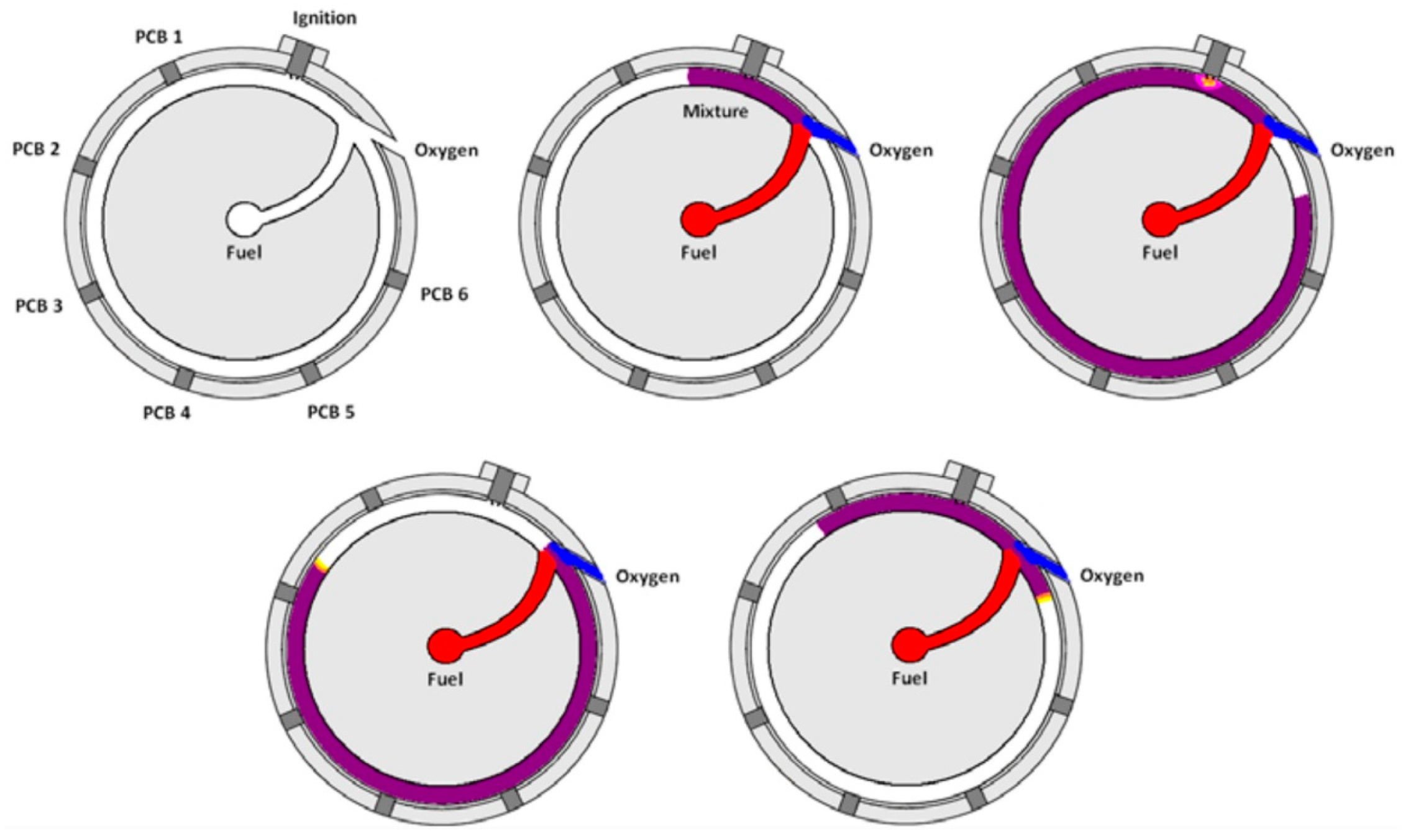

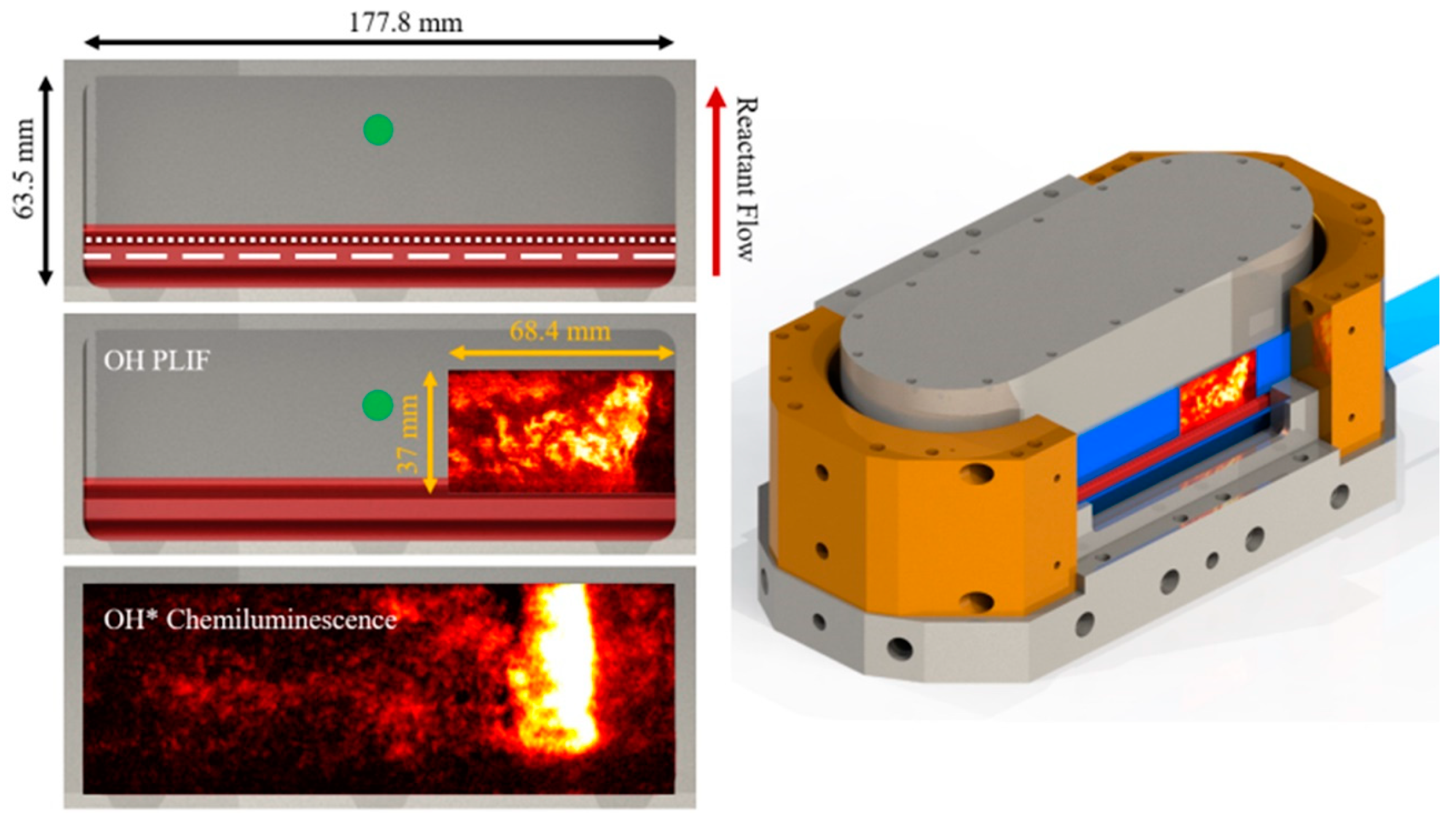

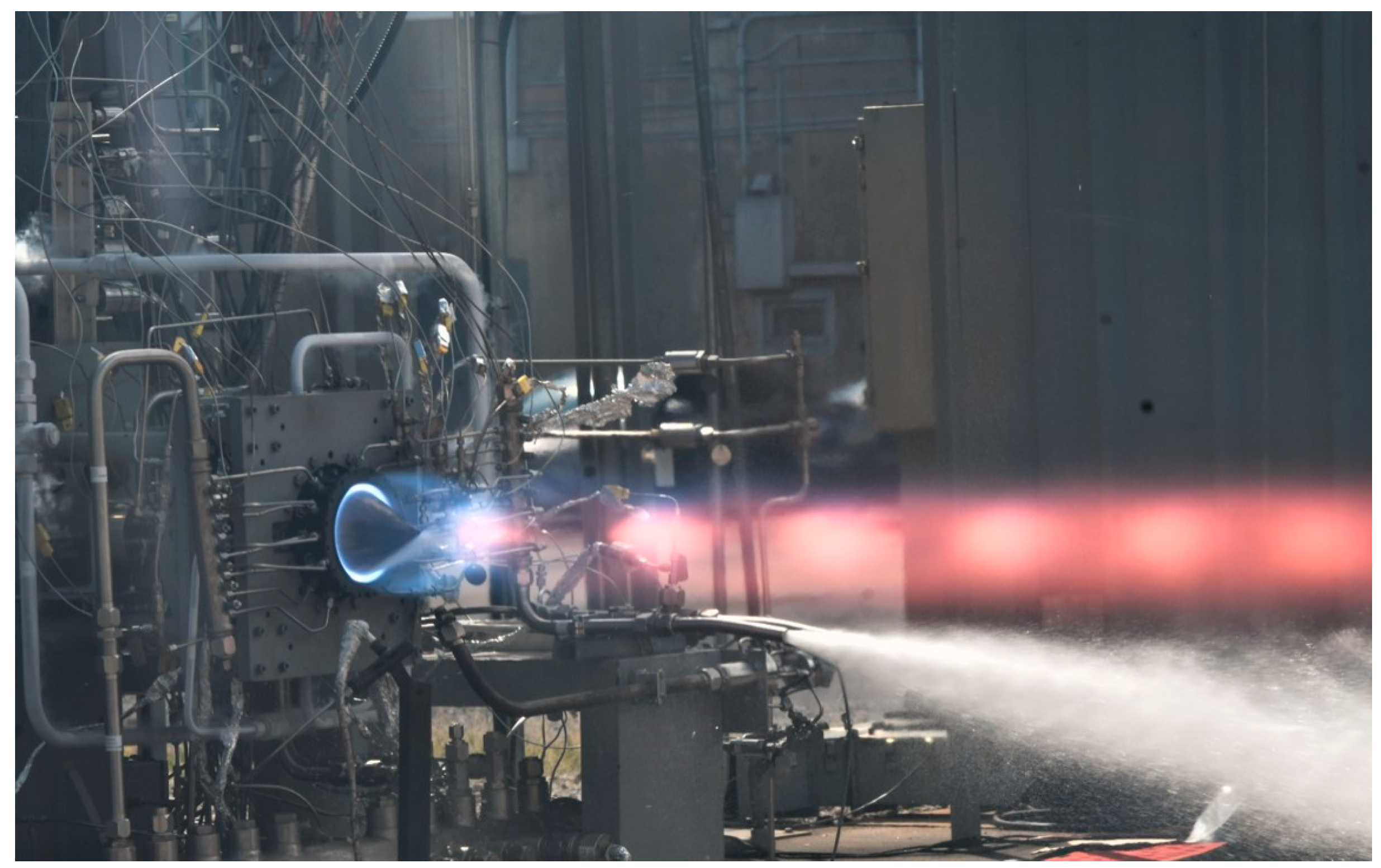
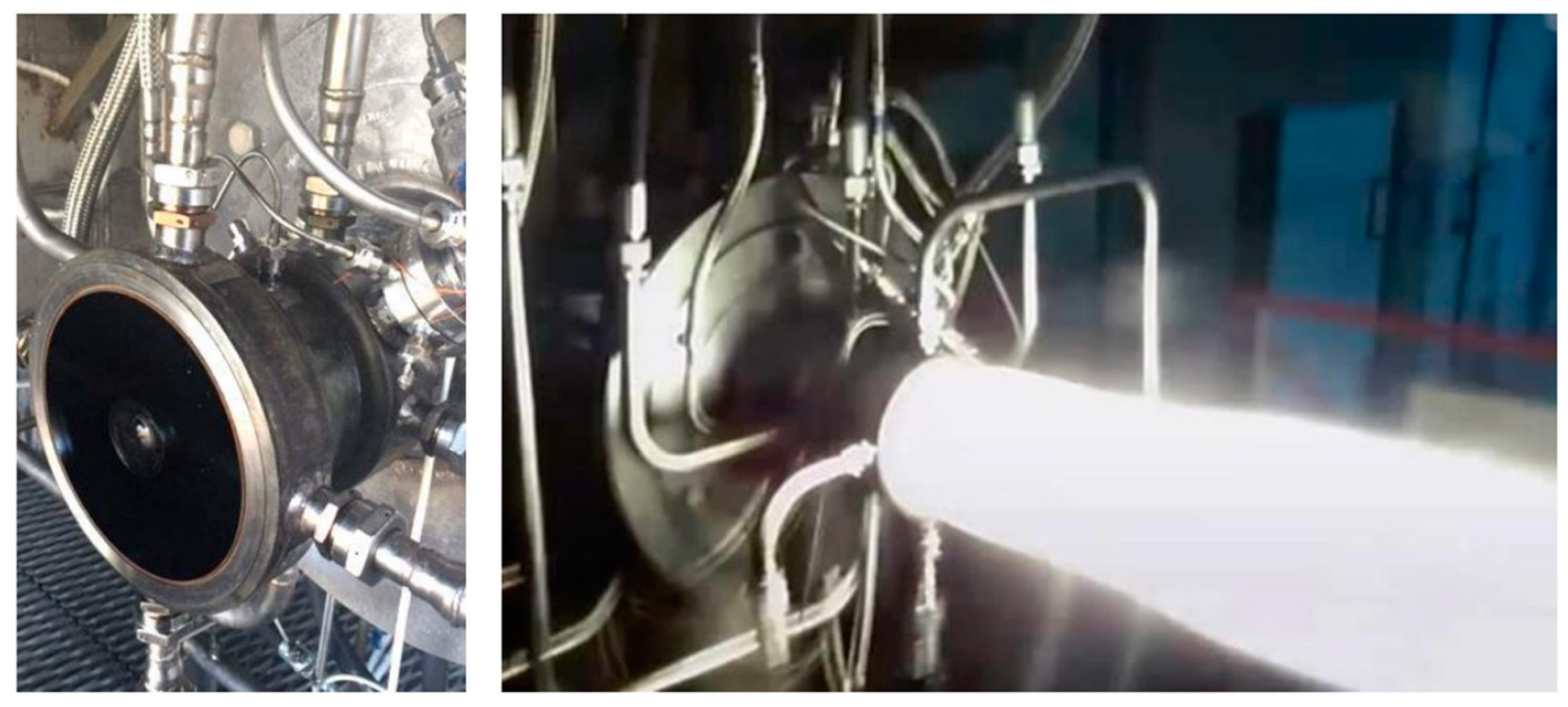
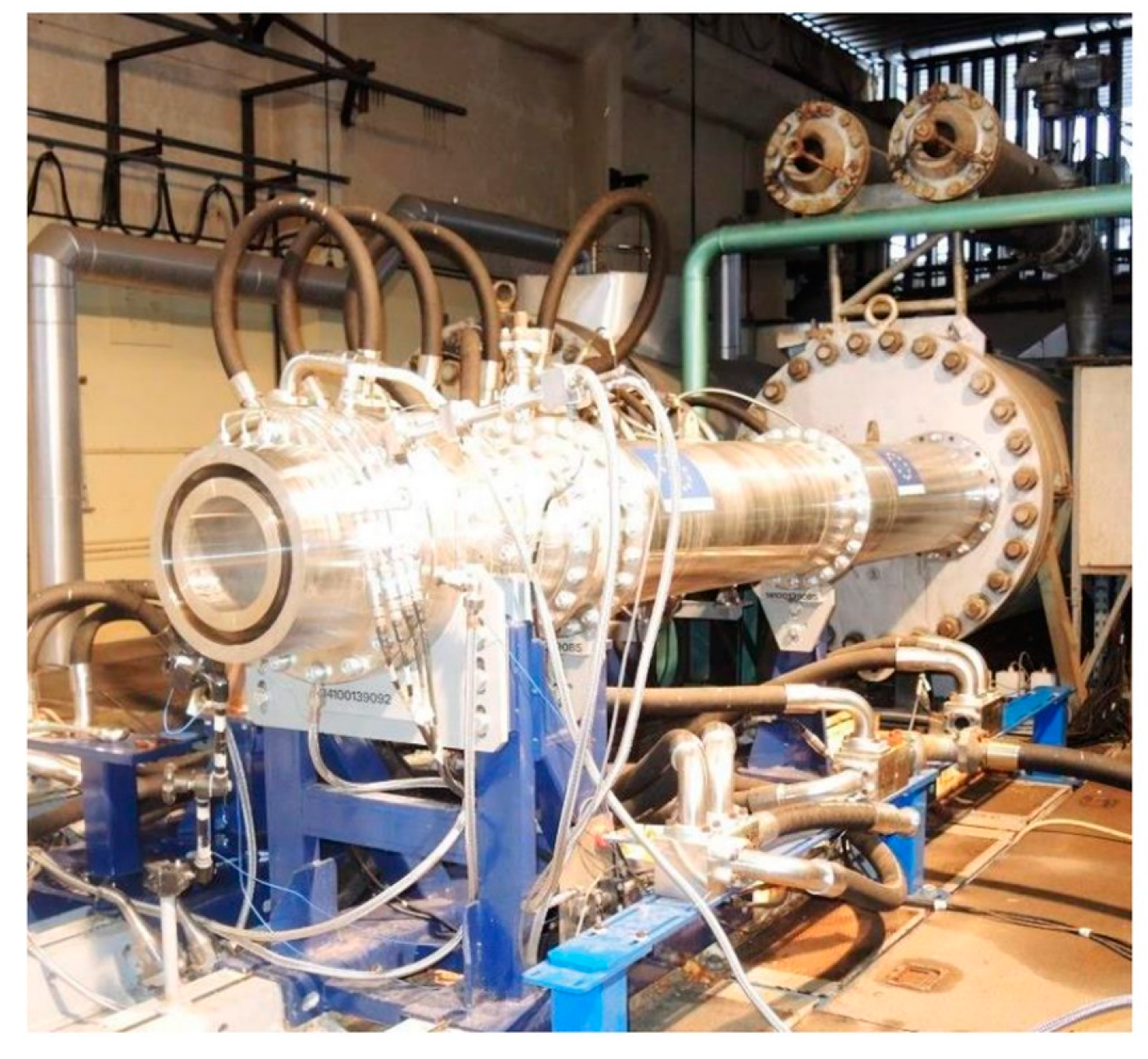

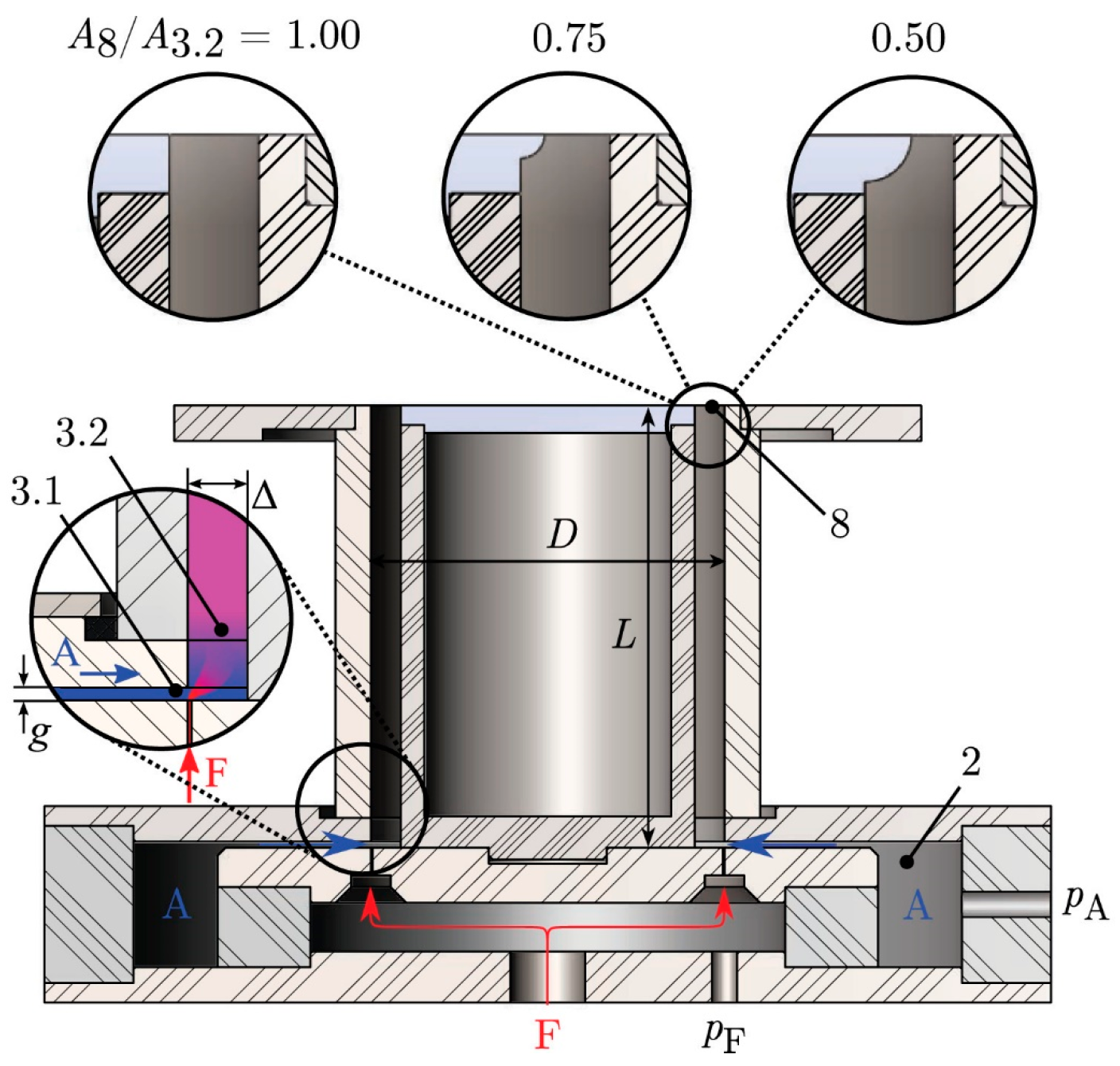
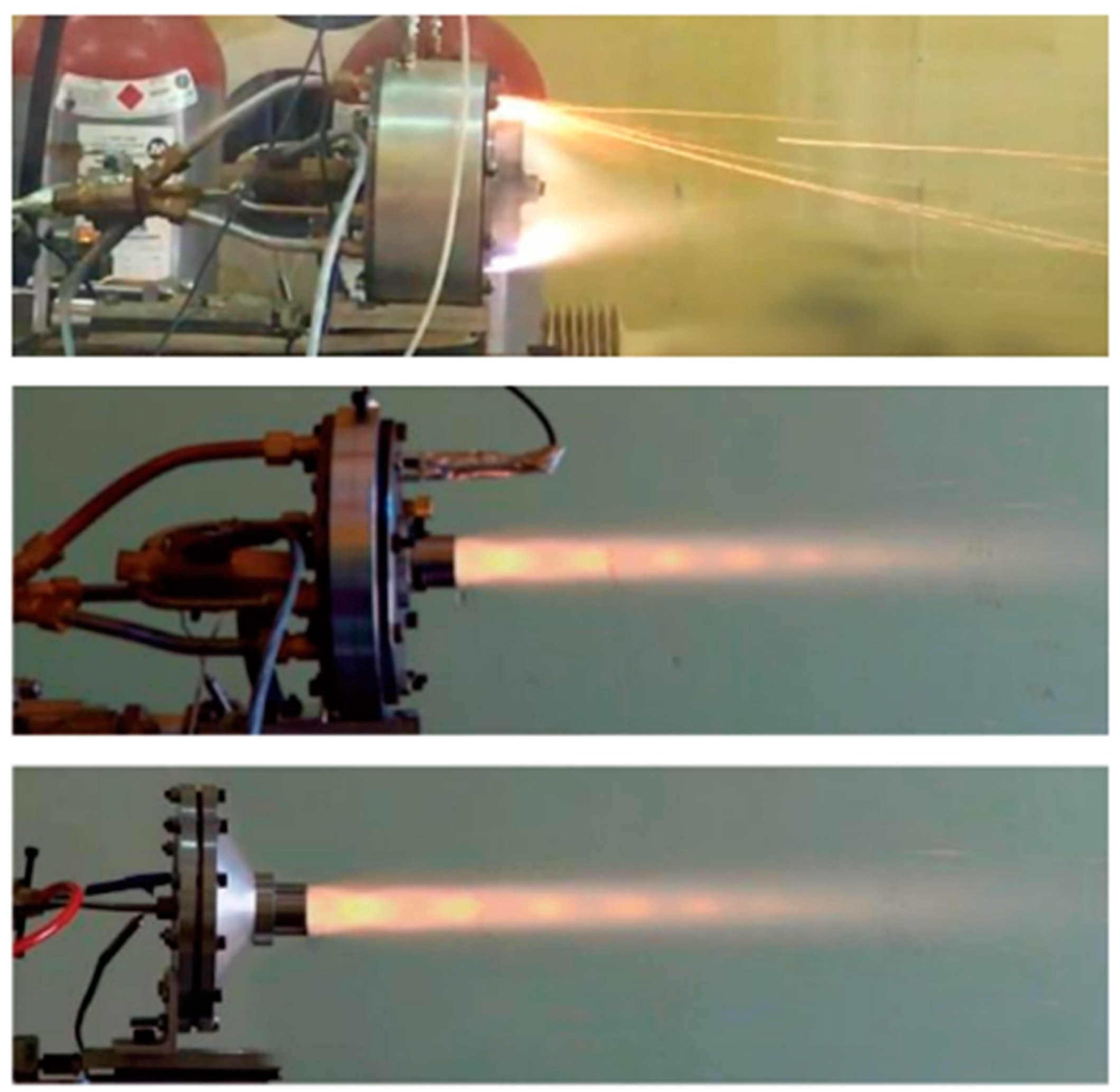
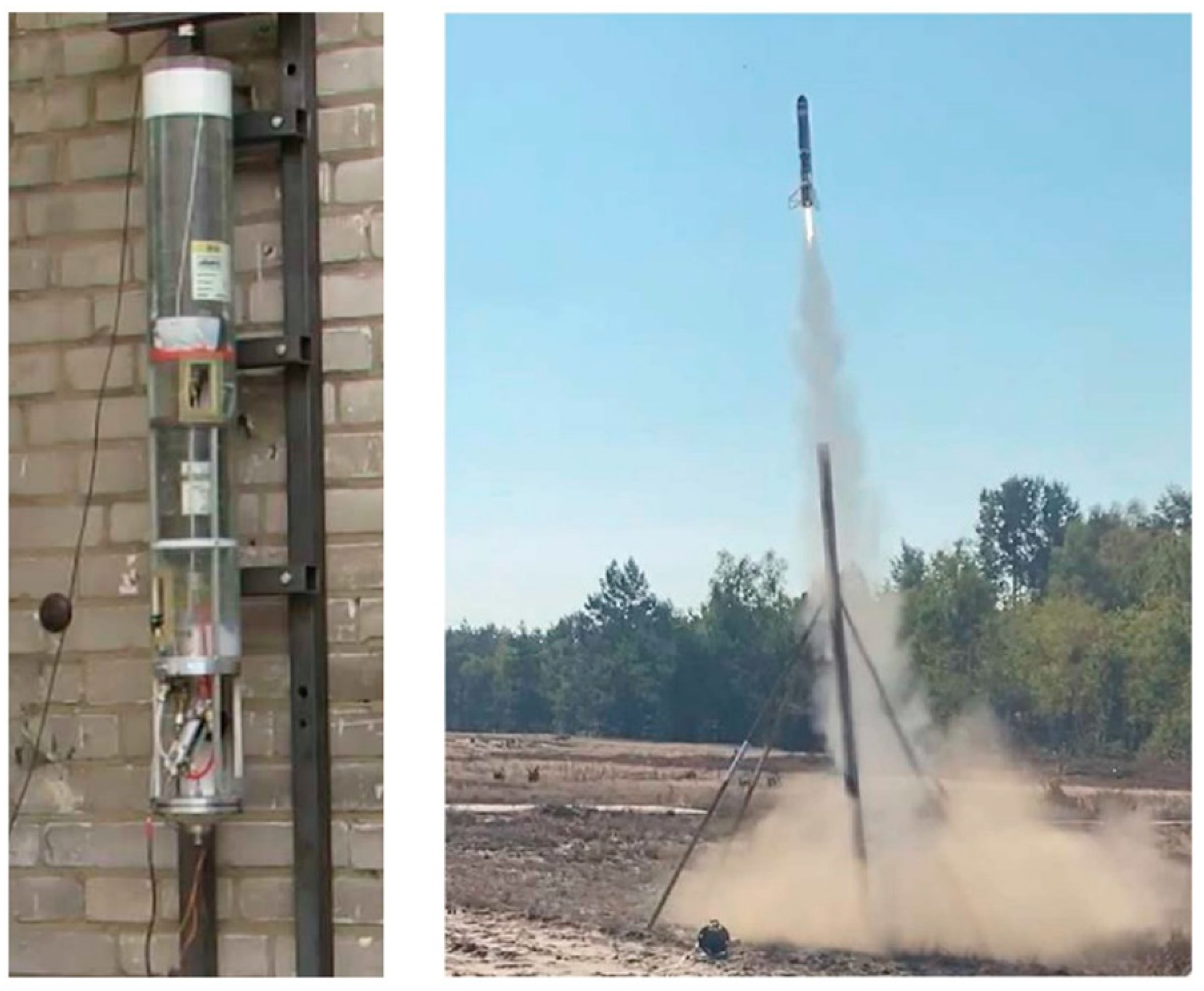

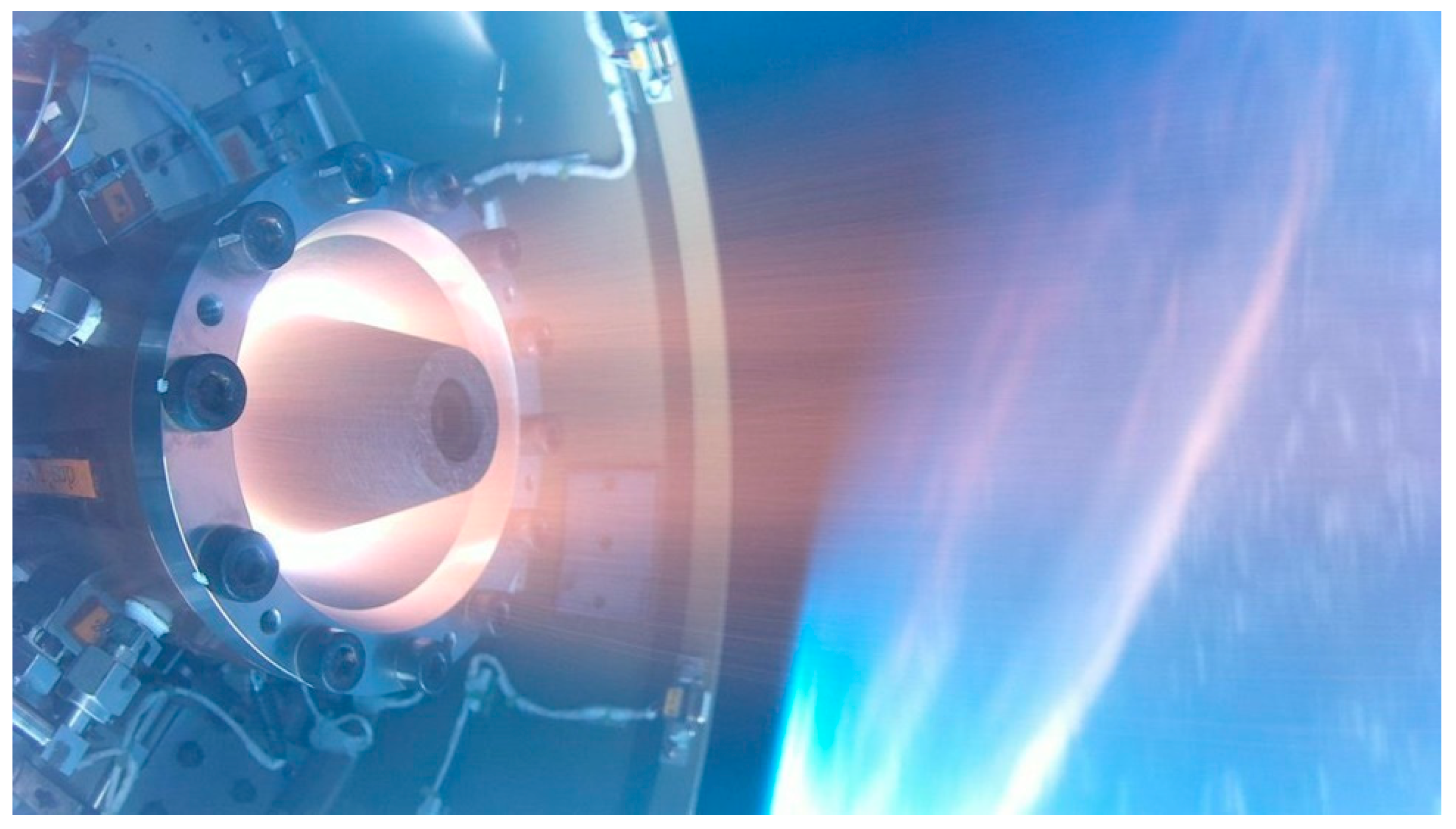

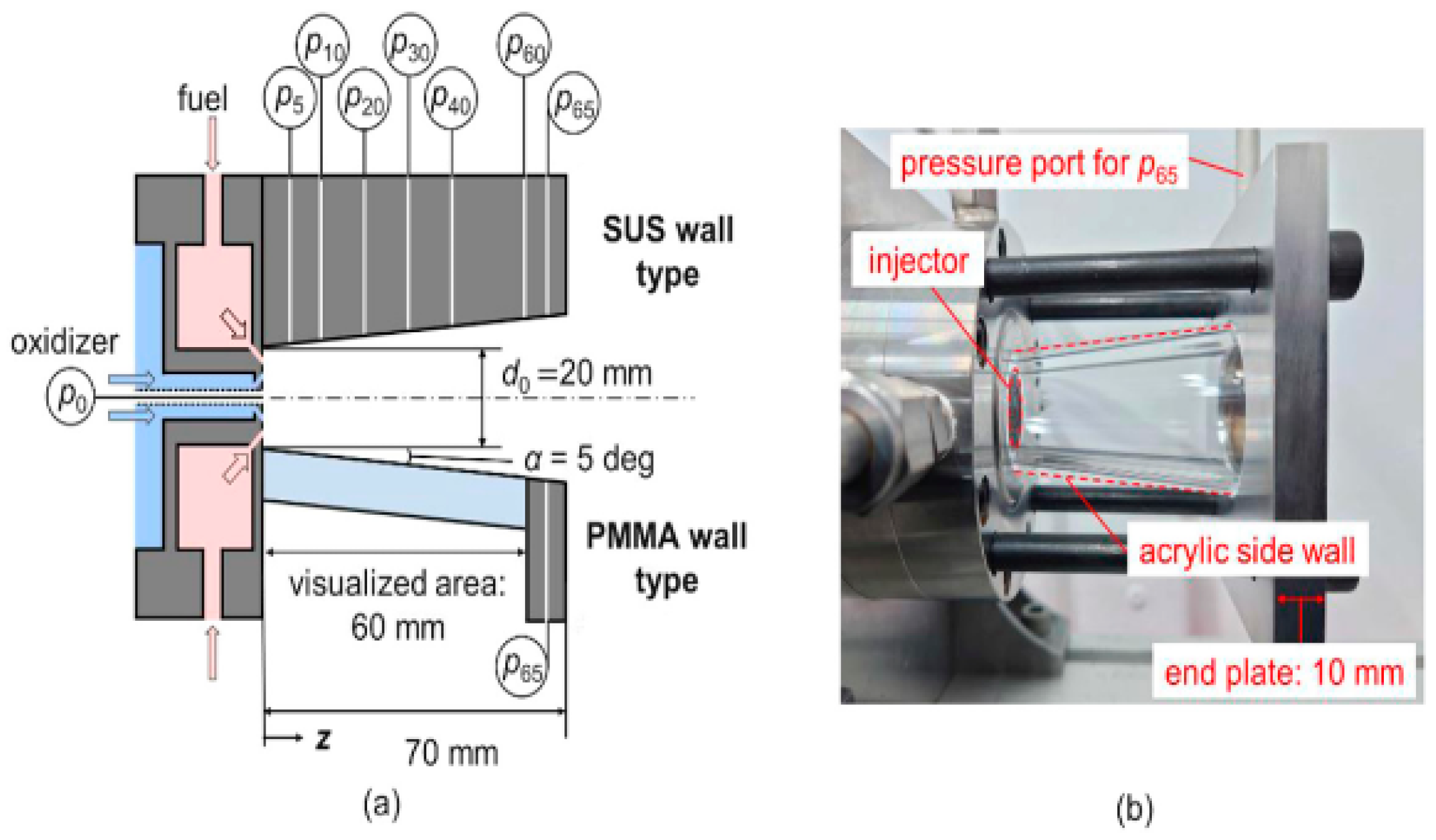

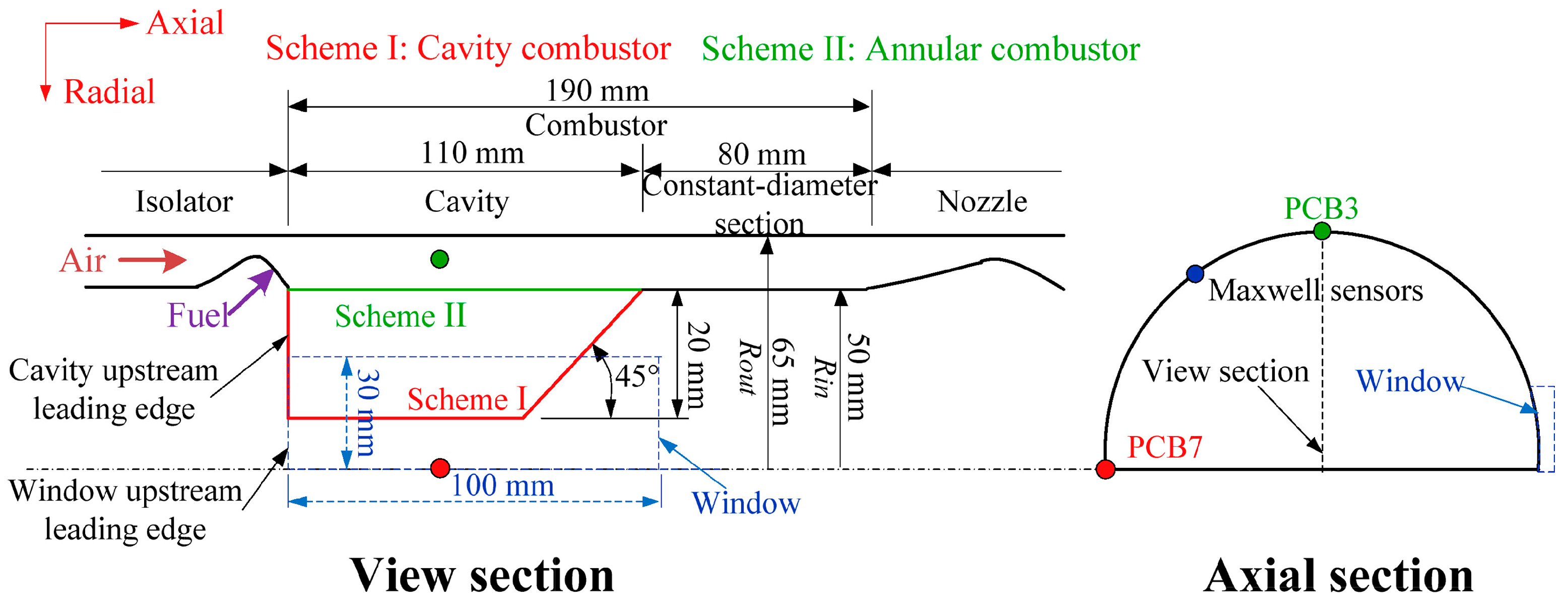

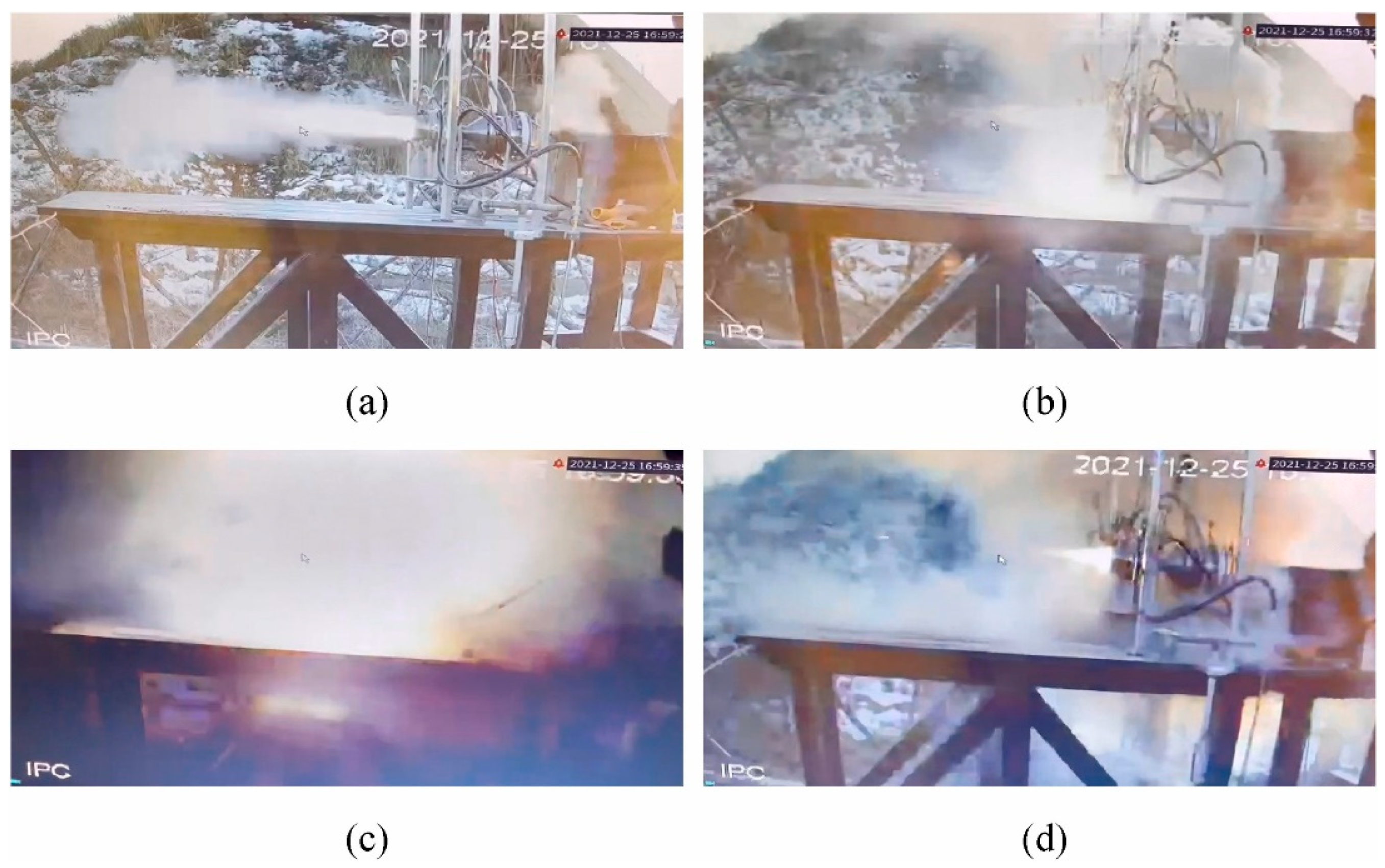
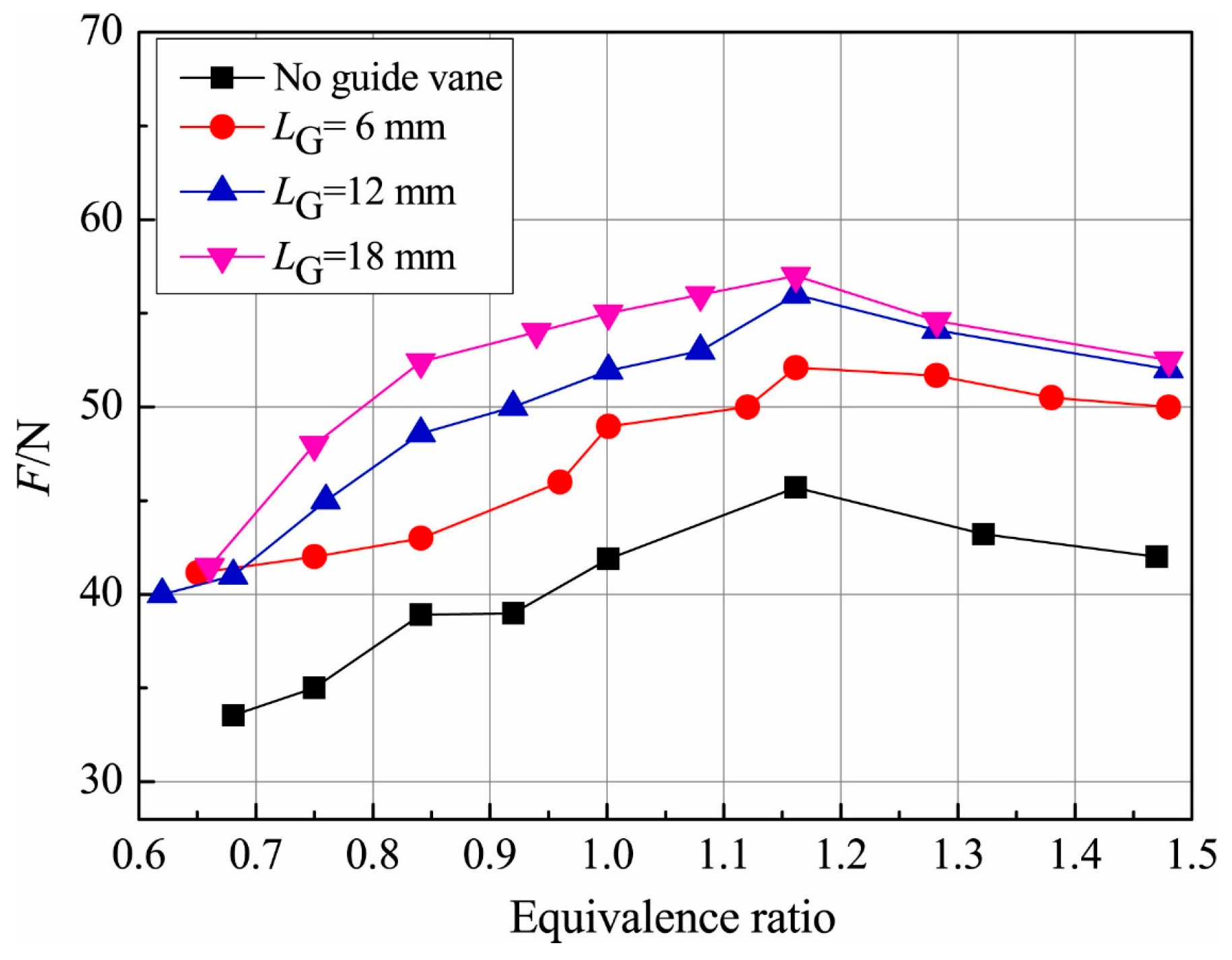
| Organization | Engine Type | Geometry | Chamber Size [mm] | Propellant | Wave Speed [m/s] | Thrust [N] | First Author | ||
|---|---|---|---|---|---|---|---|---|---|
| Outer Diameter | Channel Width | Fuel | Oxidizer | ||||||
| Texas University | Rocket | Annular | 87.6 | 4.45 | GH2, GC3H8 | GO2 | 4083 | - | Braun (2010) [11] |
| AFIT (Air Force Institute of Technology) | Rocket | Annular | 76.2 | 2, 6, 10 | GH2 | GO2 | 1013–2818 | - | Russo (2011) [12] |
| Rocket | Annular | 28 | 2 | C2H4 | GO2 | 1100–1400 | - | Keller (2024) [17] | |
| Rocket | Annular | 152.4 | 7.62 | GH2 | GO2 | 1400–1550 | - | Shank (2012) [14] | |
| Air-breathing | - | 76.2 | - | GH2 | Air | 1200–1600 | - | Tellefsen (2012) [16] | |
| University of Cincinnati | Air-breathing | Annular | 228 | 19 | GH2, C2H4 | Air | 1200–1300 | - | George (2015) [18] |
| Purdue University | Rocket | Annular | 228 | 19 | RP2 | GO2 | - | 3000 | Walters (2018) [19] |
| Rocket | Annular | 94 | 6.35 | H2O2 | C8H18O4 | 2220–2479 | - | Kubicki (2020) [20] | |
| University of Central Florida | Rocket | Annular | 76.2 | 5.1 | GH2 | GO2 | 2272–2326 | - | Sosa (2020) [21] |
| University of Michigan | Rocket | Annular (Racetrack) | 63.5 × 177.8 | - | - | Air | 1450 | - | Chacon (2018) [22] |
| University of Alabama | Rocket | Annular (Racetrack) | 101.6 (annulus, linear) | 7.62 | LC3H8 | GO2 | 975–1075 | - | Unruh (2021) [25] |
| Aerojet-Rocketdyne | Rocket Air-breathing | Annular | 100–430 | - | CH4, C2H2, C2H6, H2, LNG, JP-8, JP-10 | Air, O2 | 1000 < wave speed | - | (2018) [27] |
| AFRL (Air Force Research Laboratory) | Rocket | Annular | 76.2 | 2, 6, 10 | GH2 | Air | 684 | - | Thomas (2011) [28] |
| Rocket | Annular | 228 | 19 | RP2 | GO2 | 1160–1740 | 1020 | Rankin (2017) [30] | |
| Rocket | Annular | 152.4 | - | GH2, C2H4 | Air | - | 1360 | Fotia (2017) [32] | |
| Rocket | Annular | 76.2 | 5 | CGH4 | CO2 | 980–2200 | 1334 | Bennewitz (2021) [34] | |
| NASA | Rocket | Annular | - | - | - | - | - | 25,800 | (2023) [36] |
| Organization | Engine Type | Geometry | Chamber Size [mm] | Propellant | Wave Speed [m/s] | Thrust [N] | First Author | ||
|---|---|---|---|---|---|---|---|---|---|
| Outer Diameter | Channel Width | Fuel | Oxidizer | ||||||
| Semenov Institute of Chemical Physics | Air-breathing | Annular | 310 | - | GH2 | Air | - | 2200 | Frolov (2017) [37] |
| Air-breathing | Annular | 310 | - | GH2 | Air | - | 1500 | (2018) [38] | |
| Rocket | Annular | 406 | 25 | GH2, GH2 + LC3H8 | Air | 400–2200 | - | (2017) [39] | |
| Air-breathing | Annular | 120 | - | kerosene | Air | - | 650 (M = 1.5) 860 (M = 2.0) | Ivanov (2021) [40] | |
| Organization | Engine Type | Geometry | Chamber Size [mm] | Propellant | Wave Speed [m/s] | Thrust [N] | First Author | ||
|---|---|---|---|---|---|---|---|---|---|
| Outer Diameter | Channel Width | Fuel | Oxidizer | ||||||
| MBDA France | Rocket | Annular | 100 | 10 | GH2 | GO2 | 3100 (wave number: 2) 2750 (wave number: 3) | 338.5 | Le Naour (2011) [43] |
| Air-breathing | Annular | 330 | 25 | GH2, GH2 + kerosene | Air | 1000–1400 | - | (2017) [44] | |
| Organization | Engine Type | Geometry | Chamber Size [mm] | Propellant | Wave Speed [m/s] | Thrust [N] | First Author | ||
|---|---|---|---|---|---|---|---|---|---|
| Outer Diameter | Channel Width | Fuel | Oxidizer | ||||||
| Technical University of Berlin | Air-breathing | Annular | 90 | 7.6 | GH2 | Air | 1181–1812 | - | Bach (2019) [45] |
| Air-breathing | Annular | 90 | 7.6 | GH2 | Air | 355–1773 | - | (2021) [46] | |
| Organization | Engine Type | Geometry | Chamber Size [mm] | Propellant | Wave Speed [m/s] | Thrust [N] | First Author | ||
|---|---|---|---|---|---|---|---|---|---|
| Outer Diameter | Channel Width | Fuel | Oxidizer | ||||||
| Warsaw University of Technology | Air-breathing | Annular | 168 | - | Kerosene (add GH2, LIPN) | Air | 1350–1550 | - | Kindracki (2015) [48] |
| Institute of Aviation | Air-breathing | Annular | - | - | Jet-A Jet-A + GH2 | Air | 500–2500 | - | Wolanski (2018) [49] |
| Air-breathing | Annular | 225 | - | Jet-A Gasoline | Air | 1045–1170 | - | (2021) [50] | |
| Rocket-Ramjet combined | Annular | 130 | 3.5 | GCH4 | GO2 | - | 200 | (2019) [51] | |
| Rocket | Cone, disk, Annular | 228 | 19 | C3H8 | N2O | 1200–1300 | 250–270 | (2022) [53] | |
| Organization | Engine Type | Geometry | Chamber Size [mm] | Propellant | Wave Speed [m/s] | Thrust [N] | First Author | ||
|---|---|---|---|---|---|---|---|---|---|
| Outer Diameter | Channel Width | Fuel | Oxidizer | ||||||
| Nagoya University, Keio University, JAXA | Rocket | Annular, Hollow | 78 | Hollow 8, 16, 24, 60 | C2H4 | GO2 | 1780–2380 | 200–312 | Kawasaki (2019) [55] |
| Rocket | Annular | 78 | 8 | C2H4 | GO2 | 1293–2121 | 92–291 | Goto (2018) [56] | |
| Rocket | Annular | 78 | 8 | C2H4 CH4 | GO2 | 1213–1648 | 561 | (2021) [57] | |
| Rocket | Annular | 66.9 | 3.2 | C2H4 | GO2 | 2040 (wave number: 2) 1750 (wave number: 3) | 201 | (2021) [58] | |
| Rocket | Annular | - | - | CH4 | GO2 | - | 518 | (2022) [59] | |
| Rocket | Hollow | 20 | - | C2H4 | GO2 | 1209–1333 | 108 | Yokoo (2020) [61] | |
| Rocket | Hollow | 20 | - | LC2H6O | GO2 | 1400–1900 | 61 | Ishihara (2023) [63] | |
| Rocket | Hollow | 20 Diverging angle: 5° | - | C2H4 | GO2 | 1180–1261 | 133–234 | Nakata (2023) [64] | |
| Rocket | Hollow | 40 | - | C2H5OH | N2O | 1650–1850 | 280 | Sato (2024) [66] | |
| Rocket | Disk | 33.6 | - | C2H4 | GO2 | 900–1600 | - | Nakagami (2016) [67] | |
| Yokohama National University | Rocket | Disk | 76 | - | GH2 | GO2 | - | 75–400 | Ishii (2023) [68] |
| Organization | Engine Type | Geometry | Chamber Size [mm] | Propellant | Wave Speed [m/s] | Thrust [N] | First Author | ||
|---|---|---|---|---|---|---|---|---|---|
| Outer Diameter | Channel Width | Fuel | Oxidizer | ||||||
| National University of Defense Technology | Rocket | Annular | 100 | 5 | GH2 | Air | 1605–1790 (wave number: 1) 1329–1475 (wave number: 2) | - | Liu (2016) [69] |
| Rocket | Hollow | 100 | - | GCH4 | GO2 | 1500 | - | Wei (2015) [71] | |
| Rocket | Hollow | 100 | - | GCH4 | GO2 | 1767.8 | - | Peng (2019) [72] | |
| Air-breathing | Annular | 80 | - | GH2 | Air | 1725 | 610–824 | Liu (2017) [74] | |
| Peking University | Rocket | Annular | 78 | 10 | GH2 | GO2 | 2449 | - | Wang (2014) [77] |
| Rocket | Annular | 120 | 15 | GCH4 | Air | 1621–1646 | 14.2–400.4 | Ma (2023) [78] | |
| Rocket | Annular Hollow | 120 | 15 (annular) | GCH4 | GO2 | 1200–1650 (Annular) 1700–2700 (Hollow) | 10–350 (Annular) 50–380 (Hollow) | Zhang (2023) [79] | |
| Rocket | Annular | - | - | Burned gas of solid propellant N2 (36.5%), H2 (26.83%) | 2625 | 69 | Wu (2021) [80] | ||
| Nanjing University of Science of Technology | Rocket | Annular | 80 | 5 | GH2 | GO2 | 1621–1646 | 14.2–400.4 | Peng (2019) [81] |
| Air-breathing | Annular | 88 | 5 | GH2 | Air | 1550–1950 | - | Wu (2023) [83] | |
| Air-breathing | Annular | 136 | 4 | GH2 | Air | 1380–1530 | - | Zhou (2017) [82] | |
| Nanjing University of Aeronautics and Astronautics | Rocket | Annular | 206 | 31 | Liquid Kerosene | Air | 1575–1610 | - | Li (2024) [85] |
| Chongqing University | Air-breathing | Annular | 106 | 5 | GH2 | Air | 1550–1700 | 40–55 | Zhou (2023) [86] |
| Xi’an Aerospace Propulsion Institute | Rocket | Annular | 60 | 20 | MMH | NTO | 1350–1650 | - | Xue (2018) [87] |
Disclaimer/Publisher’s Note: The statements, opinions and data contained in all publications are solely those of the individual author(s) and contributor(s) and not of MDPI and/or the editor(s). MDPI and/or the editor(s) disclaim responsibility for any injury to people or property resulting from any ideas, methods, instructions or products referred to in the content. |
© 2024 by the authors. Licensee MDPI, Basel, Switzerland. This article is an open access article distributed under the terms and conditions of the Creative Commons Attribution (CC BY) license (https://creativecommons.org/licenses/by/4.0/).
Share and Cite
Yun, M.-S.; Roh, T.-S.; Lee, H.J. Analysis of Development Trends for Rotating Detonation Engines Based on Experimental Studies. Aerospace 2024, 11, 570. https://doi.org/10.3390/aerospace11070570
Yun M-S, Roh T-S, Lee HJ. Analysis of Development Trends for Rotating Detonation Engines Based on Experimental Studies. Aerospace. 2024; 11(7):570. https://doi.org/10.3390/aerospace11070570
Chicago/Turabian StyleYun, Min-Sik, Tae-Seong Roh, and Hyoung Jin Lee. 2024. "Analysis of Development Trends for Rotating Detonation Engines Based on Experimental Studies" Aerospace 11, no. 7: 570. https://doi.org/10.3390/aerospace11070570
APA StyleYun, M.-S., Roh, T.-S., & Lee, H. J. (2024). Analysis of Development Trends for Rotating Detonation Engines Based on Experimental Studies. Aerospace, 11(7), 570. https://doi.org/10.3390/aerospace11070570










